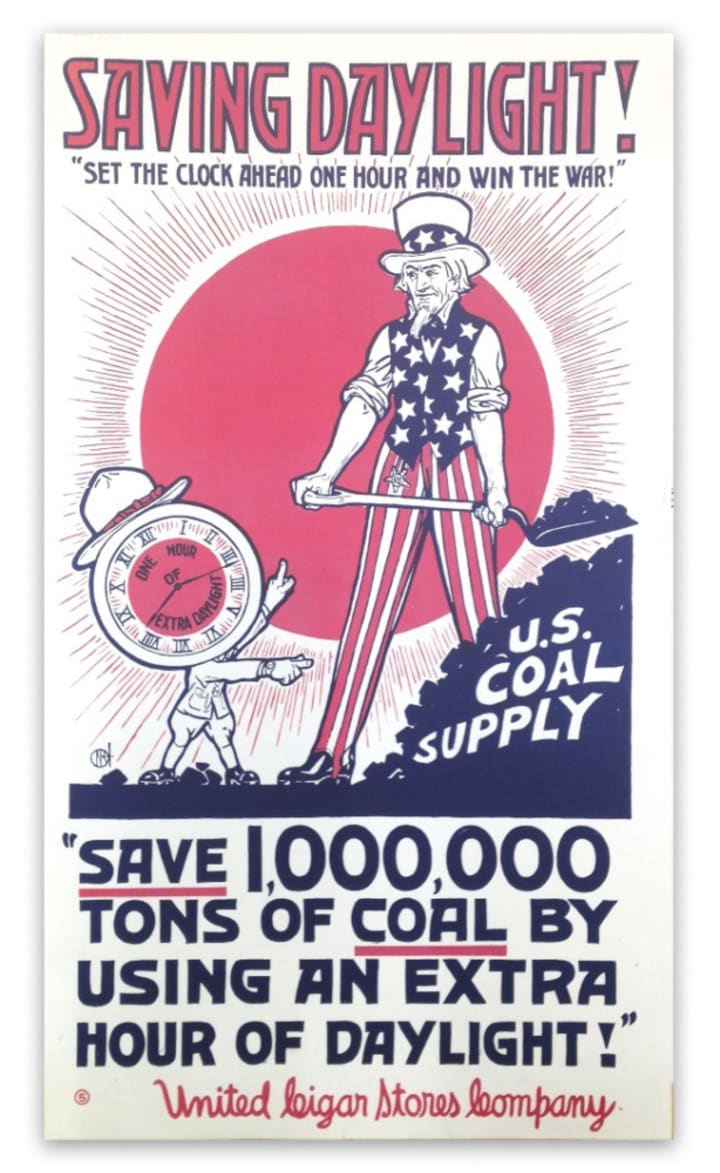Why do we spring forward and fall back every year?
A brief history of Daylight Saving Time.

It is dark here in Alaska. Cook dinner at 3:30 pm so you can be in bed by 6:00 pm dark. It happened quickly this year, like Christmas morning presents quickly. One day I was waking up to the chirping of birds and the annoying sounds across the street neighborhood mowing his grass at 6:30 am, and the next, it was the silent sounds of snow-covered roads and the hum of the overworked heater.
Who is to blame for this hibernation? I blame Daylight Saving Time. Some unknown force stole an hour of my 'sun' time this past Sunday, and I am mad. One could argue that we got an extra hour of sleep, but I would get my hour during naptime- so it is a moot point. Now, with my limited three hours of daylight- there is no luxury of a mid-day nap. Instead, I have to crame 8 hours of work, chores, errands, and living into 3 hours. Because, of course, everyone knows that it is time to cuddle up with Egg Nog and Rum in a coffee mug and watch Hallmark movies when the sun goes down.
When did we vote in Daylight Saving Time? Unfortunately, I don't remember it on any ballot! But, in my research- I know who I want to point the finger at. Benjamin Franklin! That man wrote to the <em>Journal of Paris </em>and recommended that people get out of bed earlier in spring to minimize the use of candles and lamp oil. His joke to the newspaper started all this crap- I swear by it. However, that is not enough evidence to throw the book at him. So off to research I go!
Did you know? Although modern-daylight saving time has only been used for about 100 years, ancient civilizations are known to have engaged in comparable practices thousands of years ago. For example, the Roman water clocks used different scales for different months to adjust the daily schedules to the solar time.
However, the first person of interest in the case of Daylight Saving Time is George Hudson, an entomologist from New Zealand, who in 1895, came up with the current concept of 'saving' sunlight. According to history- Hudson proposed a two-hour time shift in the spring so he'd have more hours of daylight to go bug hunting in the summer. He suggested moving clocks ahead two hours in October and then a two-hour shift back in March. What kind of bugs was he hunting?
A mere ten years later- in 1905, British builder William Willett suggested setting the clocks ahead 20 minutes on each of the four Sundays in April and then switching them back by 20 minutes on each of the four Sundays in September for a total of eight-time switches per year. Can you imagine the confusion with this practice? For six months a year, my oven shows the wrong time by just an hour- this process would have me all screwed up. Nevertheless, William proposed it to England's Parliament to prevent the nation from wasting daylight. Winston Churchill and Sir Arthur Conan Doyle championed his idea initially, but the British government rejected it. However, Willett kept arguing for the concept up until he died in 1915.
Interestingly, it was World War I where we saw the first real implication of Daylight Saving Time. In 1916, the German Empire set clocks ahead one hour to use less power for lighting and save fuel for the war effort. Germany and Austria literally decided to manhandle time and began saving daylight at 11:00 pm on April 30, 1916, by setting the clock's hands forward one hour until the following October.
Surprisingly, other countries immediately adopted this 1916 action: Belgium, Denmark, France, Italy, Luxembourg, Netherlands, Norway, Portugal, Sweden, Turkey, and Tasmania. Nova Scotia and Manitoba adopted it, with Britain following suit three weeks later, on May 21, 1916. Finally, in 1917, Australia and Newfoundland began saving daylight.

In the United States, Daylight Saving Time was first introduced on March 19, 1918, when a bill was introduced called '<em>An Act to preserve daylight and provide standard time for the United States</em>.' It both created standard time zones and set summer daylight savings time to begin on March 31, 1918. As a result, the country observed daylight Saving Time for seven months in 1918 and 1919.
Interesting side note: I found conflicting dates through numerous websites- National Geographic states that the Daylight Saving Law was introduced on March 9, 1918, along with the Standard Time Act that defines time zones in the U.S.
After World War I ended, the law proved so unpopular that it was repealed in 1919, with a Congressional override of President Wilson's veto. After that, however, Daylight Saving Time became a local option and was continued in a couple of states, such as Massachusetts and Rhode Island, and some cities, such as New York, Philadelphia, and Chicago.
During World War II, President Franklin Roosevelt re-engaged the idea of Daylight Saving Time, calling it War Time. The purpose was to conserve power and provide extra daylight for war industries to increase production. It began in February 1942 and lasted until the end of September 1945.

From 1945 to 1966, there was no federal law regarding Daylight Saving Time, so states were given the option to choose whether or not to observe it and also were able to decide when it began and ended. This freedom caused confusion, especially for the broadcasting industry, railways, airlines, and bus companies. In addition, the businesses mentioned above had to publish new schedules every time a state or town began or ended Daylight Saving Time because of the different local customs and laws.
In 1966, the Uniform Time Act of 1966 established the idea of regulating a yearly time change. Daylight Saving Time would begin the last Sunday in April and end the last Sunday in October. Clocks would be advanced one-hour beginning at 2:00 am on the last Sunday in April and turned back one hour at 2:00 am on the last Sunday in October.
States were allowed to exempt themselves from Daylight Saving Time as long as the entire state did so. However, if a state chose to observe it, the time changes were required to begin and end on the established dates. The act also required states that used Daylight Saving Time in 1966 to start it on the last Sunday in April and end it on the last Sunday in October.
Side Note- In 1967, Arizona and Michigan became the first states to exempt themselves (Michigan would begin observing it in 1972).
Dating back to Willett, daylight saving advocates have proclaimed that energy conservation was an economic benefit. But is this true? For example, a U.S. Department of Transportation study in the 1970s concluded that the total electricity savings associated with Daylight Saving Time amounted to about 1% in the spring and fall months. Unfortunately, as air conditioning has become more widespread, more recent studies have found that cost savings on lighting are more than offset by more significant cooling expenses.
However, the crisis over the clocks gets even more confusing...
During the 1973 oil embargo by the Organization of Arab Petroleum Exporting Countries (OAPEC), in an effort to conserve fuel, Congress enacted a trial period of year-round Daylight Saving Time, beginning January 6, 1974, and ending April 27, 1975.
Why would an oil embargo impact the settings on Americans clocks? Glad you asked!
The 1973 oil crisis or 'First Oil Crisis' began in October 1973 when the Organization of Arab Petroleum Exporting Countries led by Saudi Arabia proclaimed an oil embargo targeted at nations that supported Israel during the Yom Kippur War.
The initial nations targeted were Canada, Japan, the Netherlands, the United Kingdom, and the United States, with the embargo also later extended to Portugal, Rhodesia, and South Africa. By the end of the ban in March 1974, oil prices had risen nearly 300%, from $3 per barrel to almost $12 per barrel globally- U.S. prices were significantly higher! Thus, the embargo caused an oil crisis, or "shock," with many short- and long-term effects on global politics and the global economy.
The trial over oil was hotly debated. Those in favor pointed to increased daylight hours in the summer evening: more time for recreation, reduced lighting and heating demands, reduced crime, and reduced automobile accidents. The opposition was concerned about children leaving for school in the dark, and the construction industry was worried about morning accidents.
But the real issue was- who was going to pay for the oil? Looking back on history, as it is so easy to do, I would ganger to point out that the actual argument was who would pay for the rising cost of fuel? Big businesses that price-locked customers into a specific price range would lose an extraordinary amount of money because of the crisis. Instead of taking the 'L,' lawmakers and big businesses decided that slogan would be 'Better Health.' Change the clocks- more sun, more activity, less fuel usage, big business get to keep their money- everyone wins!
However, to get this plan to work- everyone needed to be on the same page. As a result, lawmakers amended the act in October 1974 to return to standard time for four months, beginning October 27, 1974 and ending February 23, 1975, when Daylight Saving Time resumed.
What was the outcome? I am glad that you asked.

A 2008 study in Indiana found that the state's adoption of Daylight Saving Time had actually increased overall energy consumption. That's because, while it might give us more exposure to sunlight, it doesn't necessarily reduce heating or air conditioning costs.
However, according to CNN.com- In 2008, the U.S. Department of Energy found that the four-week extension of DST from April-October to March-November saved about 0.5 percent in total electricity every day. While that seems like almost nothing, it totals 1.3 billion kilowatt-hours, and the DOE says that adds up to
the amount of electricity used by more than 100,000 households for an entire year.
But then, another report that same year by the National Bureau of Economic Research concluded that
DST increases the demand for electricity – even though lighting usage reduced, demand for heating and cooling increased, so electricity consumption was about the same.
Does anyone know why we do this twice a year?
The answer is no! No one knows why we still do it. But it has become a national pastime to complain about it every six months. So here we are- sitting in my office at 4:07 pm watching the street lights come on while planning my traditional bedtime ritual of being asleep by 7:30 pm.

Just for fun- did you know that Daylight Saving Time doesn't start at midnight? Nope! It actually kicks off at 2:00 am because research has proved that people are least likely to be awake at this time, which means it can happen without directly affecting many people.
Why did Daylight Saving Time move from October to the current time frame of November? Well, that is in part due to our favorite holiday- Halloween! At one time, Daylight Saving Time resulted in people gaining an extra hour on the last Sunday in October, which often fell right around Halloween. For those companies that profited the most from Halloween, including candy firms, this was seen as potentially problematic for business. The outcome? A little over ten years ago- candy companies began lobbying the United States government to push it back a couple of weeks when the candy business wasn't quite as hot. This way- kids would have longer 'daylight and safe' hours to Trick-Or-Treat! Well played candy companies- well played.
There you go, friends- the history of Daylight Saving Time! I invite you to do more research on the political reasons for DST- it is pretty fascinating! Amazingly, there are a few books written on this very topic! Who would have thought!
And as always... Be Great at something you are Good at!</p>
Further Research:
The Curious and Contentious Story of Daylight Saving Time by David Prerau
All About Daylight Saving Time: Daylight Saving Time History And More: All About Daylight Saving Time Book by Milaton Williams
Spring Forward: The Annual Madness of Daylight Saving Time by Michael Downing
About the Creator
Rose Loren Geer-Robbins
One does not simply become a famous writer! It takes many hours before the sun comes up and even more when the sun sets. I am never sure what world I am living in, the one that I am writing about or reality.






Comments
There are no comments for this story
Be the first to respond and start the conversation.